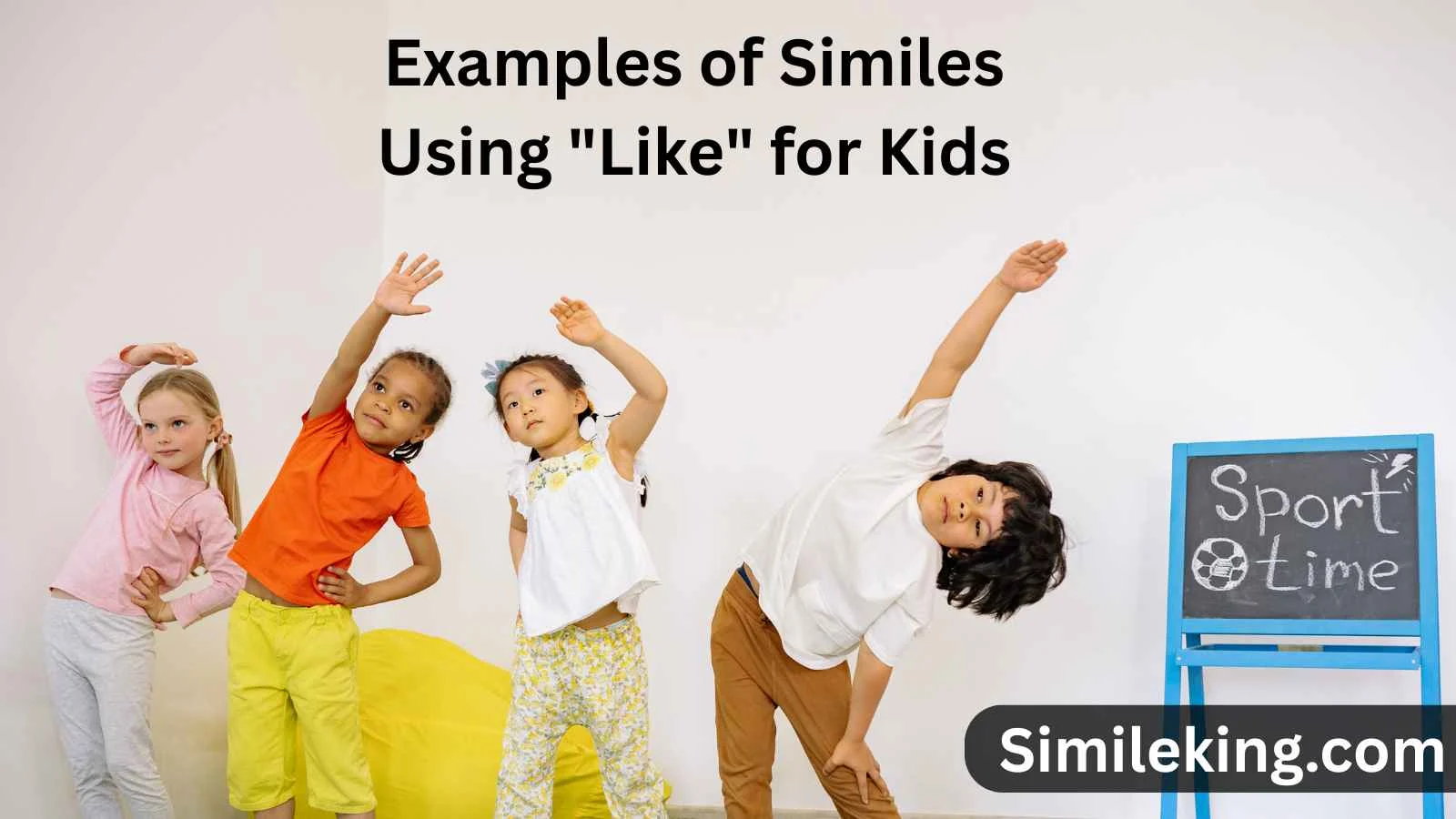Similes are a playful and powerful tool in the English language, especially for young learners. They help kids understand abstract ideas by comparing one thing to another using the words “like” or “as.” For instance, saying “He runs like a cheetah” paints a vivid picture in a child’s mind—quick, wild, and full of energy.
This article dives into 20+ kid-friendly similes using “like”—crafted to entertain, teach, and make reading and writing more enjoyable for children. Along the way, we’ll explore different tones (funny, sweet, casual, creative), real-life examples, and how to use these similes in texting or daily conversations.
What Is a Simile?
A simile is a figure of speech that compares two different things using the word “like” or “as.” It helps describe something by saying it is similar to something else.
Example:
- “The clouds are like cotton candy.”
This doesn’t mean the clouds are sweet and edible—it means they look soft and fluffy, like cotton candy.
Why Are Similes Important for Kids?
Similes:
- Spark creativity
- Help express emotions and actions vividly
- Build vocabulary and imagination
- Make writing and storytelling more engaging
- Improve reading comprehension
How to Spot a Simile
Look for phrases that use:
- like a… (e.g., like a lion)
- as…as (e.g., as quick as lightning) — though this article focuses more on “like” similes.
20+ Similes Using “Like” for Kids
Here’s a curated list of fun, easy-to-understand similes that use “like,” ideal for kids in writing, speech, or conversation.
1. As fast as a cheetah
He runs like a cheetah on the playground.
2. Like a cloud in the sky
Her dress floated like a cloud in the wind.
3. Like a lion’s roar
His shout was like a lion’s roar.
4. Like a flashlight in the dark
Her smile was like a flashlight in the dark.
5. Like a rock in a river
He stood still like a rock in a river.
6. Like popcorn popping
Her thoughts jumped like popcorn popping.
7. Like a puzzle missing a piece
The story felt confusing, like a puzzle missing a piece.
8. Like a kangaroo on a trampoline
He bounced like a kangaroo on a trampoline.
9. Like syrup on pancakes
His kindness was like syrup on pancakes—sweet and warm.
10. Like ice on a sunny day
Her anger melted away like ice on a sunny day.
11. Like a whisper in the wind
His voice was like a whisper in the wind.
12. Like fireworks in the sky
The celebration was like fireworks in the sky.
13. Like a bee in a flower
She buzzed around the classroom like a bee in a flower.
14. Like crayons in a box
The kids were as colorful as crayons in a box.
15. Like a balloon floating away
His daydreams drifted like a balloon floating away.
16. Like a turtle on vacation
He moved like a turtle on vacation—slow and relaxed.
17. Like marbles in a jar
Their ideas clashed like marbles in a jar.
18. Like rain on a tin roof
The tapping of her pencil was like rain on a tin roof.
19. Like glitter in the sun
Her dress sparkled like glitter in the sun.
20. Like music to my ears
His laugh was like music to my ears.
21. Like a robot with no batteries
She felt tired, like a robot with no batteries.
Choosing the Right Simile Based on Tone
Different similes create different moods or tones. Here’s how you can decide which simile works best depending on the situation:
| Tone | Best Similes | Use Case |
|---|---|---|
| Playful | Like a kangaroo on a trampoline | Jokes, silly stories |
| Comforting | Like syrup on pancakes | Writing get-well cards, bedtime stories |
| Imaginative | Like popcorn popping | Creative writing, storytelling |
| Dramatic | Like a lion’s roar, Like fireworks | Action scenes, emotional moments |
| Descriptive | Like glitter in the sun | Describing people, outfits |
How to Teach Similes to Kids
Here are a few fun and effective methods to help children grasp similes quickly:
1. Use Picture Books
Books like “Owl Moon” or “Quick as a Cricket” use similes beautifully.
2. Draw It Out
Let kids draw a picture based on a simile like “as bright as a star”.
3. Create Simile Charts
Use themes (e.g., animals, food, nature) and let kids create their own comparisons.
4. Simile Matching Game
Match beginnings like “She’s as fast…” with endings like “…as a racing car.”
7 Google-Optimized Texting Examples (Kid-Friendly)
These kid-appropriate text messages are simple, creative, and optimized for SEO purposes.
- “Your hair looks like cotton candy today 🍬✨”
- “I miss you like a puppy misses its owner 🐶❤️”
- “You’re bouncing like a kangaroo on sugar 😄🦘”
- “Your laugh is like sunshine after rain 🌞🌧️”
- “I feel like a robot with no batteries today 🤖😴”
- “Her smile was like a flashlight in my dark day 💡🙂”
- “This cake tastes like happiness on a spoon 🎂😋”
Polite, Professional, and Casual Variations of “Similes Using Like for Kids”
Since the phrase “similes using like for kids” can sound repetitive or technical, here are different tone-adjusted alternatives:
Polite:
- “Child-friendly simile examples using ‘like’”
- “Educational similes for young learners”
- “Age-appropriate simile comparisons for students”
Professional:
- “Curriculum-based similes for primary education”
- “Simile sentence examples tailored for elementary students”
- “Comparative language tools for English learners”
Casual:
- “Fun similes kids will love”
- “Easy ‘like’ similes for children”
- “Cool similes to help your kid write better stories”
How Similes Help in Formal vs Informal Conversations
| Type | Use of Similes |
|---|---|
| Formal | Helps in essays, reading tests, storytelling units |
| Informal | Adds humor and charm to texts, games, and casual talk |
Similes like “as brave as a lion” can work in both essay assignments and personal messages, showing their versatility.
FAQs About Similes for Kids
Q1. Are similes and metaphors the same?
No. Similes use “like” or “as.” Metaphors do not.
Simile: She swims like a fish.
Metaphor: She is a fish in water.
Q2. Can children make up their own similes?
Absolutely! It boosts creativity and writing skills.
Q3. Is it okay to use silly or funny similes?
Yes! Similes should be fun and relatable for kids—humor is encouraged.
Conclusion
Using similes with “like” is a delightful way for kids to explore language and spark their imagination. Whether they’re describing a friend, a moment, or their favorite food, similes help them express themselves in more colorful and memorable ways.
Teachers, parents, and young learners alike can benefit from this list of 20+ similes—and the variations in tone make it easier to adapt them for any purpose. From bedtime stories to classroom writing prompts, these comparisons will stick with children for a long time.
Encourage kids to come up with their own similes. Who knows? Their creativity might just be like a shooting star lighting up the night sky.





